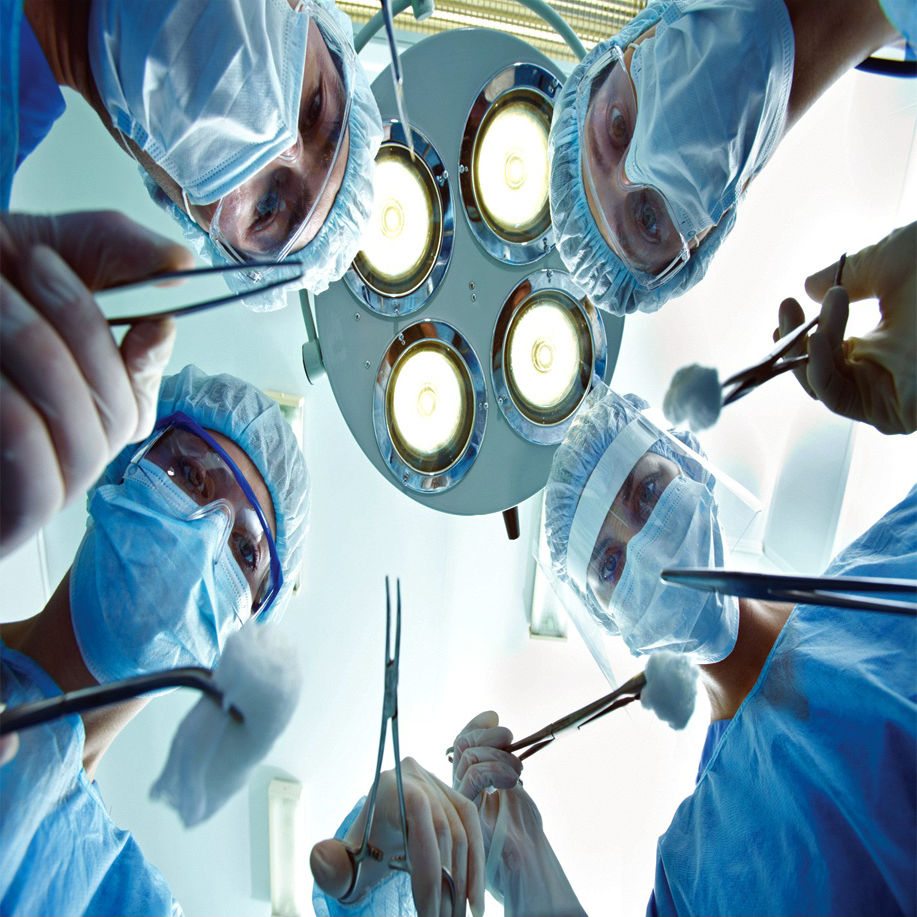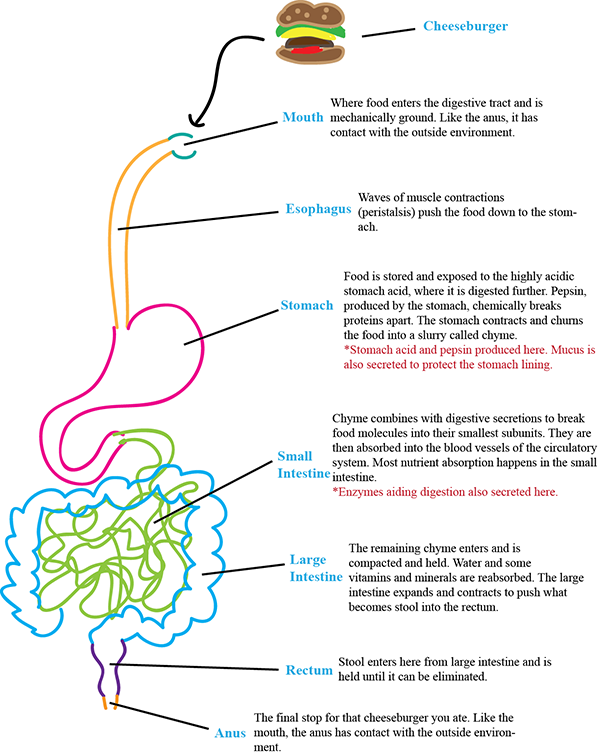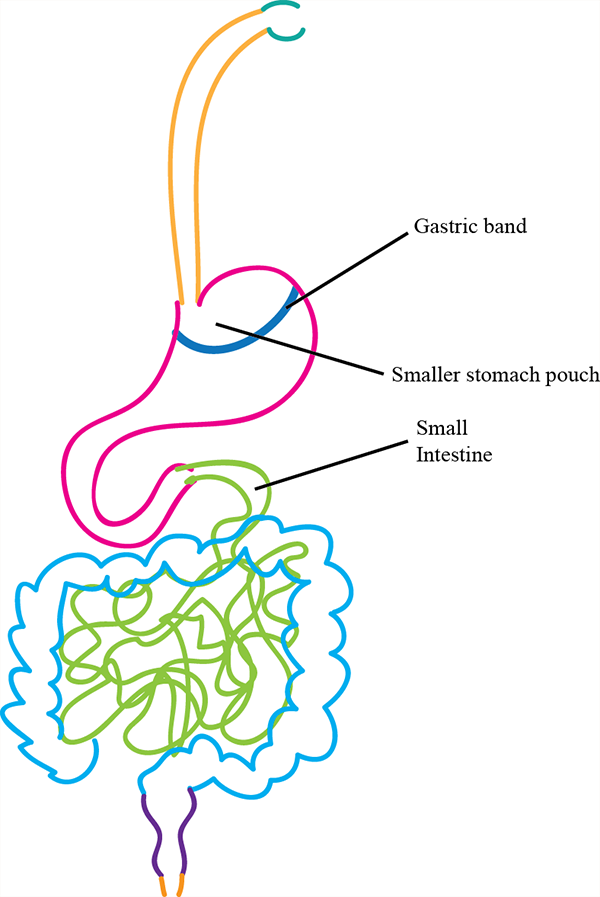
Chapter 1. Chapter 26: Digestive System
1.1 Introduction


Welcome to the Interactive Study Guide for Chapter 26: Digestive System! This Study Guide will help you master your understanding of the chapter's Driving Questions, using interactive Infographics and activities, as well as targeted assessment questions. Click "Next" to get started, or select a Driving Question from the drop-down menu to the right.
Drastic Measures:
For the morbidly obese, stomach-shrinking surgery is a last resort
DRIVING QUESTIONS
- What is the anatomy of the digestive system?
- How is food broken down and absorbed as it moves through the digestive tract?
- What are the risks and benefits of bariatric surgery?
1.2 Driving Question 1:
Driving Question 1
What is the anatomy of the digestive system?
Why should you care?
According to the American Society for Metabolic and Bariatric Surgery, 220,000 bariatric surgeries were performed in 2008, an increase of 15,000 from 2007. As of this writing, final numbers from 2009 are expected to be higher still, a pattern predicted to continue into the future. Not surprisingly, this predicted increase is attributed to two factors: an aging population and the obesity epidemic, two major risk factors for diabetes. Bariatric surgery is not, however, a panacea; to understand why not, we need first to understand the basic structure and function of the digestive system.
What should you know?
To fully answer this Driving Question, you should be able to:
- Draw the organs that are part of the digestive tract and describe their general function.
- Draw the accessory organs of the digestive system and describe their general function.
- Describe peristalsis and compare and contrast its function in the esophagus and in the stomach.
Infographic Focus
The Infographics most pertinent to the Driving Question are 26.1, 26.2, 26.4, 26.5, and 26.7.
Test Your Vocabulary
Choose the correct term for each of the following definitions:
| Term | Definition |
|---|---|
| The first portion of the small intestine; the duodenum receives chyme from the stomach and mixes it with digestive secretions from other organs. | |
| Glands that secrete enzymes, including salivary amylase, which digests carbohydrates, into the mouth. | |
| The organ system that breaks down food molecules, absorbs nutrients, and eliminates waste; it is composed of the digestive tract and accessory organs. | |
| To break up large fat globules into smaller fat droplets that can be more efficiently chemically digested by enzymes. | |
| The first and longest portion of the large intestine; the colon plays an important role in water reabsorption. | |
| The expulsion of undigested matter in the form of stool. | |
| An expandable muscular organ that stores, mechanically breaks down, and digests proteins in food. | |
| The central pathway of the digestive system; it is a long muscular tube that pushes food between the mouth and the anus. | |
| The organ in which the bulk of chemical digestion and absorption of food occurs. | |
| An organ that stores bile salts and releases them as needed into the small intestine. | |
| An organ that helps digestion by producing enzymes (such as lipase) that act in the small intestine and by secreting a juice that neutralizes acidic chyme. | |
| The section of the digestive tract between the mouth and the stomach. | |
| A protein-digesting enzyme that is active in the stomach. | |
| The mechanical and chemical breakdown of food into subunits, enabling the absorption of nutrients. | |
| The acidic soup of partially digested food that leaves the stomach and enters the small intestine. | |
| An organ that aids digestion by producing bile salts, which emulsify fats. | |
| The last organ of the digestive tract, in which remaining water is absorbed and solid stool is formed. | |
| Solid waste material eliminated from the digestive tract. | |
| Coordinated muscular contractions that force food down the digestive tract. | |
| The act of taking food into the mouth. | |
| Chemicals produced by the liver and stored by the gallbladder that emulsify fats so that they can be chemically digested by enzymes. |
Draw the digestive organs through which food passes and describe their general function.
1.
In your notebook, draw the path a cheeseburger would take through your digestive tract from first bite to elimination.
Next to each organ you drew, briefly explain its function.
List on your diagram any secretions produced by these organs.

Draw the accessory organs of the digestive system and describe their general function.
2.
In your notebook, add all of the accessory organs of the digestive system to your drawing.
Next to each organ you drew, briefly explain its function.
List any excretions produced by these organs.

3.
Give a general explanation of what the digestive system does and why it is important.
Describe peristalsis and compare and contrast its function in the esophagus and in the stomach.
4.
Describe peristalsis.
5.
What is the function of peristalsis in the esophagus?
6.
What is the function of peristalsis in the stomach?
Review Questions
7.
Which of the following correctly pairs an organ of the digestive tract with its secretion?
| A. |
| B. |
| C. |
| D. |
| E. |
8.
The accessory organs of the digestive tract can be removed without harming normal functioning of the digestive tract.
| A. |
| B. |
9.
What distinguishes the digestive tract organs from the digestive tract accessory organs? (Mark "yes" for all that apply.)
| a. Accessory organs do not physically interact with the digestive tract. | |
| b. The organs of the digestive tract connect through one long, continuous tube. | |
| c. The accessory organs do not come in direct contact with food. | |
| d. You can survive without your accessory organs. |
1.3 Driving Question 2:
Driving Question 2
How is food broken down and absorbed as it moves through the digestive tract?
Why should you care?
Although the small intestine is approximately 20 feet long, most of the chemical breakdown of our food occurs in the top 10 inches. Within this short space, secretions from several organs are added, and the salad you ate is finally broken down into its smallest components—the amino acids, sugars, fatty acids, and so on that your body needs. Gastric bypass surgery diverts food around this critical region, which helps explain both why the surgery leads to weight loss and why it can lead to nutrient deficiency.
What should you know?
To fully answer this Driving Question, you should be able to:
- Explain the two functions of stomach acid.
- Explain the function of the liver and gallbladder in digestion.
- List the secretions of the pancreas and give the function of each.
- Explain how villi make the small intestine capable of absorbing large quantities of nutrients.
- Describe the primary roles of the large intestine in digestion by describing what happens to chyme as it passes through this organ.
Infographic Focus
The Infographics most pertinent to the Driving Question are 26.2, 26.4, 26.5, and 26.7.
Test Your Vocabulary
Choose the correct term for each of the following definitions:
| Term | Definition |
|---|---|
| The first portion of the small intestine; the duodenum receives chyme from the stomach and mixes it with digestive secretions from other organs. | |
| An organ that stores bile salts and releases them as needed into the small intestine. | |
| The acidic soup of partially digested food that leaves the stomach and enters the small intestine. | |
| Fingerlike projections of folds in the lining of the small intestine that are responsible for most nutrient and water absorption. | |
| A fat-digesting enzyme active in the small intestine. | |
| An organ that helps digestion by producing enzymes (such as lipase) that act in the small intestine and by secreting a juice that neutralizes acidic chyme. | |
| A protein-digesting enzyme that is active in the stomach. | |
| An organ that aids digestion by producing bile salts that emulsify fats. | |
| Cells that line organs and body cavities; in the digestive tract they sit in direct contact with food and its breakdown products. | |
| Glands that secrete enzymes, including salivary amylase, which digests carbohydrates, into the mouth. | |
| The organ in which the bulk of chemical digestion and absorption of food occurs. | |
| The uptake of digested food molecules by the epithelial cells lining the small intestine. | |
| To break up large fat globules into smaller fat droplets that can be more efficiently chemically digested by enzymes. | |
| Chemicals produced by the liver and stored by the gallbladder that emulsify fats so that they can be chemically digested by enzymes. |
Explain the two functions of stomach acid.
10.
List and explain the two functions of stomach acid.
Explain the function of the liver and gallbladder in digestion.
11.
Why must fat droplets be pretreated with special chemicals before they can be broken down by digestive enzymes?
12.
What is the name of the process by which fat droplets are broken up?
13.
What is the name of the chemicals that pretreat fat droplets, and where are they produced? Where are they stored?
List the secretions of the pancreas and give the function of each.
14.
List the major secretions of the pancreas and their functions.
Explain how villi make the small intestine capable of absorbing large quantities of nutrients.
15.
What are villi, and how do they increase the absorptive quality of the small intestine?
Describe the primary roles of the large intestine in digestion by describing what happens to chyme as it passes through this organ.
16.
List and describe what happens to chyme, beginning with its entry into the large intestine and ending with its elimination.
Next, whatever material is left is pushed into the rectum. Here the waste material, or stool, as it is called at this point, is held until it is ready to be eliminated through the anus (the exit and second opening of the digestive tract).
Review Questions
17.
If you were developing a diet pill that blocked the absorption of a portion of nutrients, where would you likely target this drug to have the greatest effect?
| A. |
| B. |
| C. |
| D. |
18.
Which liver product (stored in the gallbladder) emulsifies fats in the small intestine?
| A. |
| B. |
| C. |
| D. |
19.
Which of the following correctly pairs a secretion of the digestive system with its function?
| A. |
| B. |
| C. |
| D. |
| E. |
1.4 Driving Question 3:
Driving Question 3
What are the risks and benefits of bariatric surgery?
Why should you care?
Gastric bypass is one of the most common forms of bariatric surgery. Although it can help morbidly obese people lose weight and consequently reduces their risk of developing diabetes and heart disease, it is not to be taken lightly. Knowing exactly how the surgery changes the structure of the digestive system is the first step to understanding why.
Gastric banding, an alternative to gastric bypass surgery, has recently been approved for people who are obese but not severely enough to be appropriate candidates for gastric bypass. It provides several advantages over gastric bypass but may not be as attractive to some patients.
Gastric bypass and gastric banding were developed to help the morbidly obese lose weight and improve their long-term health. Each carries risks, and gastric bypass carries a number of unpleasant side effects. Are the results worth the risk? Do the procedures actually work? We can answer these questions by looking at recent scientific studies.
What should you know?
To fully answer this Driving Question, you should be able to:
- Illustrate how gastric bypass changes the structure of the stomach and small intestine.
- Diagram gastric banding.
- Compare and contrast gastric banding with gastric bypass in terms of the structural changes each makes to the digestive system and to the passage of food through the digestive tract.
- Compare and contrast the mechanisms by which gastric banding and gastric bypass lead to weight loss.
- Discuss the advantages and disadvantages of gastric banding relative to gastric bypass.
Infographic Focus
The Infographics most pertinent to the Driving Question are 26.3, 26.6, and 26.8.
Test Your Vocabulary
Choose the correct term for each of the following definitions:
| Term | Definition |
|---|---|
| Cells that line organs and body cavities; in the digestive tract they sit in direct contact with food and its breakdown products. | |
| The acidic soup of partially digested food that leaves the stomach and enters the small intestine. | |
| The uptake of digested food molecules by the epithelial cells lining the small intestine. | |
| The first portion of the small intestine; the duodenum receives chyme from the stomach and mixes it with digestive secretions from other organs. | |
| To break up large fat globules into smaller fat droplets that can be more efficiently chemically digested by enzymes. | |
| Fingerlike projections of folds in the lining of the small intestine that are responsible for most nutrient and water absorption. | |
| An expandable muscular organ that stores, mechanically breaks down and digests proteins in food. | |
| An organ that aids digestion by producing bile salts, which emulsify fats. | |
| An organ that stores bile salts and releases them as needed into the small intestine. | |
| Solid waste material eliminated from the digestive tract. | |
| A fat-digesting enzyme active in the small intestine. | |
| The expulsion of undigested matter in the form of stool. | |
| A protein-digesting enzyme that is active in the stomach. | |
| The organ in which the bulk of chemical digestion and absorption of food occurs. | |
| Chemicals produced by the liver and stored by the gallbladder that emulsify fats so that they can be chemically digested by enzymes. |
Illustrate how gastric bypass surgery changes the structure of the stomach and small intestine.
20.
In your notebook, draw a diagram of the lower esophagus, stomach, and small intestine after gastric bypass surgery.

Diagram the gastric banding procedure.
21.
In your notebook, draw a diagram of the lower esophagus, stomach, and small intestine after gastric bypass surgery.

Compare and contrast gastric banding with gastric bypass surgery in terms of the structural changes each makes to the digestive system and to the passage of food through the digestive tract.
22.
Compare and contrast the effects of gastric banding and gastric bypass to the structure of the digestive system and to the passage of food through the digestive tract by completing the table.
| Change(s) to Structure of Upper Stomach (be specific) | Change(s) to Small Intestine (be specific) | Change(s) to Passage of Food Through Stomach | Change(s) to Passage of Food Through Small Intestine | |
| Gastric bypass |
Fill in below:
A single mutation in a tumor suppressor gene associated with DNA repair.
|
Fill in below:
A single mutation in a tumor suppressor gene associated with DNA repair.
|
Fill in below:
A single mutation in a tumor suppressor gene associated with DNA repair.
|
Fill in below:
A single mutation in a tumor suppressor gene associated with DNA repair.
|
| Gastric binding |
Fill in below:
A single mutation in a tumor suppressor gene associated with DNA repair.
|
Fill in below:
A single mutation in a tumor suppressor gene associated with DNA repair.
|
Fill in below:
A single mutation in a tumor suppressor gene associated with DNA repair.
|
Fill in below:
A single mutation in a tumor suppressor gene associated with DNA repair.
|
Compare and contrast the mechanisms by which gastric banding and gastric bypass lead to weight loss.
23.
List the mechanism or mechanisms by which gastric bypass leads to weight loss. (Review your earlier answers and the table above if necessary.)
24.
List the mechanism(s) by which gastric banding leads to weight loss.
25.
Summarize the similarities and differences you have identified in one or two sentences.
Discuss the advantages and disadvantages of gastric banding relative to gastric bypass.
26.
List and briefly describe the advantages of gastric banding over gastric bypass.
27.
List and briefly describe the disadvantages of gastric banding over gastric bypass.
Review Questions
28.
Both gastric banding and gastric bypass:
| A. |
| B. |
| C. |
| D. |
29.
Which procedure is appropriate for a patient who needs to lose weight very quickly?
| A. |
| B. |
30.
Which patient would lose more weight in a given time? Patient A eats 1,200 calories a day and has undergone gastric bypass. Patient B eats 1,200 calories a day.
| A. |
| B. |
Activity results are being submitted...